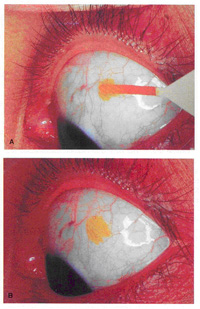 Although FBUT (fluorescein break up time) is one of the most commonly used dry eye testing techniques, the current testing method is old and unreliable. The objective of measuring FBUT is to determine if the tear film is stable by observing the actual TBUT (tear break up time). Currently the invasive manner of FBUT testing disrupts the tear film. The DET provides a less invasive way to test FBUT without disrupting the stability of the tear film for a reliable result.
FBUT testing with traditional fluorescein strips floods the 3 to 7 µL tear film with up to 17 µL of fluid. Once applied, the observer cannot determine what fluid is actually the patient's tear film and how much was applied by the strip. FBUT may falsely be measured higher than the actual TBUT. When a high FBUT is falsely noted, dry eye may be overlooked.
DET revolutionizes FBUT testing. DET has been designed to optimally measure FBUT without disrupting the nature of the tear film. DET strips are impregnated with 0.12 mg of fluorescein sodium. The slim tip of the DET is 80% smaller than the traditional fluorescein strip. This design enhancement allows the precise placement of only 1 µL of fluid onto the bulbar conjunctiva, placing just enough fluorescein into the tear film without disrupting the stability of the tear film. Adding only a trace amount of fluorescein and preserving tear film stability produces a repeatable, consistent FBUT. Also, because the DET tip is considerably smaller than the traditional strip, the patient feels little or no sensation upon application to the bulbar conjunctiva and experiences no discomfort whatsoever.
DET is the only accurate, easy to use, patient friendly method for testing dry eye on the market! |
 |

Application of DET strips
Images from "Comparison of Fluorescein Break-Up Time Measurement Reproducibility Using Standard Fluorescein Strips Versus the Dry Eye Test (DET) Method"
Cornea 20(8): 811-815, 2001. © 2001 Lippincott Williams & Wilkins, Inc., Philadelphia |